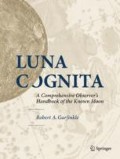Abstract
The nearside of the Moon visible in earthshine during the total solar eclipse on March 29, 2006. Image taken by Alson Wong at Salloum, Egypt. This eclipse sequence of exposures was combined into a 32-bit HDR image using Photomatix® software. The resulting image was processed in Photoshop CS5®. The image was sharpened using a layer created by subtracting a Radial Blur from the original image. A slightly enlarged image of the lunar disk was pasted into the center to obscure artifacts created by the motion of the Moon during the sequence of exposures. (North up.)
Access this chapter
Tax calculation will be finalised at checkout
Purchases are for personal use only
Notes
- 1.
Agnes Giberne, Sun, Moon, Stars (Chicago: Thompson & Thomas, 1908), 62.
- 2.
The youngest verifiable unaided-eye sighting of a waxing crescent Moon is 15.4 hours past new moon by Julius Schmidt of Athens on September 14, 1871. At sunset, the true altitude of the Moon was 8.8° and the true difference between the Sun and Moon was 2.8°. With optical equipment, the record appears to be the observation of the Moon at age 11 hours 40 minutes (3:10.05 UT) at Rask bala, Iran, by Moshen Ghazi Mirsaeed of Tehran, Iran on September 7, 2002. He used 40×150 binoculars. Refer to M. Barlow Pepin, “In Quest of the Youngest Moon,” Sky & Telescope (December 1996), 104–106; Roger Sinnott, “Seeking Thin Crescent Moons,” Sky & Telescope (February 2004), 102–105; and Bradley E. Schaefer, Imad A. Ahmad, and LeRoy Doggett, “Records for Young Moon Sightings” Quarterly Journal of the Royal Astronomical Society, 34 (March 1993), 53–56.
- 3.
Johannes Kepler, Kepler’s Somnium, translated by Edward Rosen (Madison, WI: Univ. Wisconsin Press, 1967), 136, 137.
- 4.
Pliny, Natural History, Books 1–2, translated by H. Rackham, (Cambridge, MA: Harvard Univ. Press Loeb Classical Library, 330, 1938), Book II, Chapter XI, paragraph 58, page 207.
- 5.
André Danjon, L’Astronomie 46 (February 1932), 57. Translation from the French is quoted in “The Danjon Limit of First Visibility of the Lunar Crescent” by Louay F. Fatoohi and others in The Observatory, 118 (April 1988), 65.
- 6.
Bradley E. Schaefer, “Length of the Lunar Crescent” Quarterly Journal of the Royal Astronomical Society, 32 (September 1991), 265–277.
- 7.
I use double quote marks (“ ”) around lunar feature names that are not (as of 2019) officially adopted by the IAU for use on the Moon.
- 8.
I have endeavored to use photographs and images taken by my amateur astrophotographers friends, but to better show you what limb area and in some cases tiny features really look like, I have resorted to using spacecraft imaginary and electronic maps.
- 9.
Joseph W. Merrill, The People’s Cabinet (Boston, By the Editor, 1844), 329.
- 10.
In the Atlas and Gazetteer of the Near Side of the Moon, (1971), pages 399 [frame 1285-1.1] and 415 [frame 192-3.4] part of the cluster west of Auzout includes the now unofficial satellite craters of “Auzout F,” “Auzout G,” “Auzout GA”, “Auzout S,” and “Auzout T.”
- 11.
H. P. Wilkins, “A Vanished Lunar Crater” Pop. Astro. 55 (4) (No. 544) (April 1947), 197–199.
- 12.
Edmund Neison, The Moon: and the Condition and Configuration of its Surface (London: Longmans, Green, and Co, 1876), 145.
- 13.
Based on the IAU standards for translations of non-Latin alphabet spelled names into English, the spelling of this crater’s name in English differs from the conventional way it is usually translated from the Cyrillic. This is one of many lunar feature names that do not match standard translations of an honoree’s name into English, which is the language used in the IAU nomenclature database lists.
- 14.
Johann Schröter, Selenotopographische Fragmente, (1791), 167.
- 15.
R. M. Fry, ed. Who’s Who in the Moon (1938), 20.
- 16.
In Figure 7.119, several of the names applied by Julius Schmidt were changed or moved to other features by the IAU in 1932. In the figure, number 4 is still Eimmart, number 5 (“Oriani”) is now Plutarch, number 6 (“Timoleon”) is now Hubble, number 7 (Plutarchus) is now Seneca, and number 8 (Seneca) is now Gauss.
Author information
Authors and Affiliations
Rights and permissions
Copyright information
© 2020 Springer Science+Business Media, LLC, part of Springer Nature
About this chapter
Cite this chapter
Garfinkle, R.A. (2020). Crater-Hopping: Observing the Moon on Days 1 and 2. In: Luna Cognita. Springer, New York, NY. https://doi.org/10.1007/978-1-4939-1664-1_7
Download citation
DOI: https://doi.org/10.1007/978-1-4939-1664-1_7
Published:
Publisher Name: Springer, New York, NY
Print ISBN: 978-1-4939-1663-4
Online ISBN: 978-1-4939-1664-1
eBook Packages: Physics and AstronomyPhysics and Astronomy (R0)

